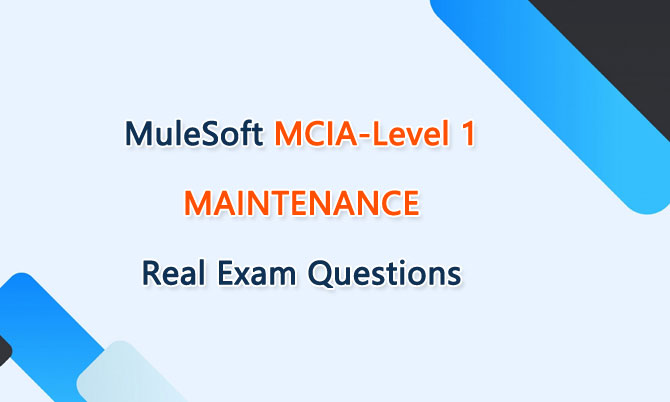MuleSoft MCIA-Level 1 MAINTENANCE real exam questions are the latest version in the market. The MCIA-Level 1 MAINTENANCE exam validates that a MuleSoft Certified Integration Architect-Level 1 has maintained the knowledge and skills to be able to drive and be responsible for an organization's Anypoint Platform implementation and the technical quality, governance, and operationalization of the integration solutions, and can work with technical and non-technical stakeholders to translate functional and non-functional requirements into integration interfaces and implementations. Use the latest MCIA-Level 1 MAINTENANCE real exam questions to pass the test in a short time.

MuleSoft MCIA-Level 1 MAINTENANCE Exam
MuleSoft MCIA-Level 1 MAINTENANCE exam basic information is available below.
Format: Multiple-choice, closed book, proctored, online
Length: 25 questions
Duration: 45 minutes
Pass score: 70%
Language: English
The MuleSoft MCIA-Level 1 MAINTENANCE certification is valid for 2 years from the date you pass the test.
MuleSoft MCIA-Level 1 MAINTENANCE Exam Topics
The following are the details of MuleSoft MCIA-Level 1 MAINTENANCE exam topics.
Initiating integration solutions on Anypoint Platform
Designing for the runtime plane technology architecture
Designing architecture using integration paradigms
Designing and developing Mule applications
Designing automated tests for Mule applications
Designing integration solutions to meet persistence requirements
Designing integration solutions to meet reliability requirements
Designing integration solutions to meet performance requirements
Designing integration solutions to meet security requirements
Applying DevOps practices and operating integration solutions
Share some MuleSoft MCIA-Level 1 MAINTENANCE Real Exam Questions
MuleSoft MCIA-Level 1 MAINTENACE real exam questions are the best material for you to test the above MuleSoft Certified Integration Architect - Level 1 MAINTENANCE topics. Share some MuleSoft certification MCIA-Level 1 MAINTENANCE real exam questions and answers below.
1.An organization is designing multiple new applications to run on CloudHub in a single Anypoint VPC and that must share data using a common persistent Anypoint object store V2 (OSv2). Which design gives these mule applications access to the same object store instance?
A. AVM connector configured to directly access the persistence queue of the persistent object store
B. An Anypoint MQ connector configured to directly access the persistent object store
C. Object store V2 can be shared across cloudhub applications with the configured osv2 connector
D. The object store V2 rest API configured to access the persistent object store
Answer: D
2.An ABC Farms project team is planning to build a new API that is required to work with data from different domains across the organization. The organization has a policy that all project teams should leverage existing investments by reusing existing APIs and related resources and documentation that other project teams have already developed and deployed. To support reuse, where on Anypoint Platform should the project team go to discover and read existing APIs, discover related resources and documentation, and interact with mocked versions of those APIs?
A. Design Center
B. API Manager
C. Runtime Manager
D. Anypoint Exchange
Answer: D
3.An organization has chosen Mulesoft for their integration and API platform. According to the Mulesoft catalyst framework, what would an integration architect do to create achievement goals as part of their business outcomes?
A. Measure the impact of the centre for enablement
B. build and publish foundational assets
C. agree upon KPI's and help develop and overall success plan
D. evangelize API's
Answer: C
4.An organization uses one specific CloudHub (AWS) region for all CloudHub deployments. How are CloudHub workers assigned to availability zones (AZs) when the organization's. Mule applications are deployed to CloudHub in that region?
A. Workers belonging to a given environment are assigned to the same AZ within that region.
B. AZs are selected as part of the Mule application's deployment configuration.
C. Workers are randomly distributed across available AZs within that region.
D. An AZ is randomly selected for a Mule application, and all the Mule application's
CloudHub workers are assigned to that one AZ
Answer: C
5.An automation engineer needs to write scripts to automate the steps of the API lifecycle, including steps to create, publish, deploy and manage APIs and their implementations in Anypoint Platform. What Anypoint Platform feature can be used to automate the execution of all these actions in scripts in the easiest way without needing to directly invoke the Anypoint Platform REST APIs?
A. Automated Policies in API Manager
B. Runtime Manager agent
C. The Mule Maven Plugin
D. Anypoint CLI
Answer: D
